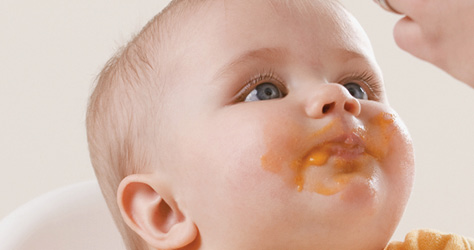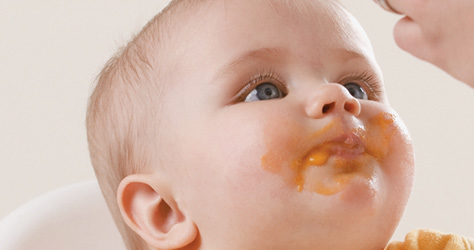Do you always have to sterilise bottles? When can your baby have cow’s milk?
Here are some questions answered about feeding your baby when they’re over six months.
At a glance
- The reason to switch babies from bottles to cups is for oral health reasons
- Follow-on milk is aimed at babies aged six months to one year
- Growing-up milk aimed at toddlers over one year old


When can I stop sterilising bottles?
Never, really! Bacteria thrives in milk, and bottles/teats are tricky to clean so should be sterilised. The official advice is to switch from bottles to cups for their milk at around 12 months because cups are easier to clean in hot, soapy water you don’t need to sterilise them. Also some babies begin to associate bottle feeding with comfort and as they get older it can become harder and harder for them to give up the bottle.
Are ‘hungry baby’ formula milks and follow-on milks necessary?
No, says the NHS, which recommends exclusive breastfeeding in the first six months. There are so many types of formula milk now for different ages and stages it can get confusing for mums. These are the main types:
- First infant formulas – these are suitable from birth and you can keep using them right up until you change to cows milk when your baby has their first birthday
- Formulas aimed at ‘hungrier babies’. These contain a higher proportion of casein (one of the proteins in the milk) than ordinary first formula milks, to try to keep babies feeling fuller for longer. Ask your health visitor for advice if you’re considering using one as there’s no evidence they work. The NHS says: “There is little nutritional difference between this formula and first infant formula. Although it is often described as suitable for ‘hungrier babies’ there is no evidence that babies settle better or sleep longer when fed this type of formula”Comfort milks - these can be used for new born babies and are aimed at those with digestive problems such as colic and mild constipation. The differences are: the protein is partially hydrolysed, some of the milk sugar (lactose) is replaced with starch and they have different fat blends. They may help some babies but babies grow out of colic as they get older anyway.
- Follow-on milk aimed at babies aged six months to one year. This has more of some nutreints including iron and shouldn’t be used for babies under six months. The NHS says: “Research has found no clear benefit from its use” The NHS adds: “Some follow-on formula has cereal added to it, and is described as a ‘nighttime feed for babies’. This type of formula is not necessary and there is no evidence that babies settle better or sleep longer when fed this. It should never be given to babies under six months old”
- Growing-up milk aimed at toddlers over one. This has extra iron and some vitamins/nutrients such as vitamin D. The NHS doesn’t recommend these either and says it’s fine to use first formula from whenever you stop breastfeeding until your baby is one. Then you can move to cow’s milk. Your baby will get iron and other nutrients from their food and a vitamin D supplement.
Can you combine breast and bottle?
Some mums like to move from only breastfeeding to a mix of breast and bottle, perhaps if they’re going back to work (although it’s perfectly possible to keep on exclusive breastfeeding while working if you want to do that. It’s all about getting into an expressing routine.) If you do want to cut down on breastfeeding at six months or older, give yourself plenty of time and take it gradually, one feed at a time. It takes between a few days and a week for your breasts to get used to dropping one feed. If you’re going back to work, it makes sense to keep the early morning and evening feeds, which your baby will love and will help you feel more comfortable too.
If your baby’s not used to a bottle for expressed milk, it can be a tricky transition at first. Try asking someone else, like your partner, to feed them as you will be closely associated with the more familiar breastmilk! You could also experiment with different styles of teats and bottles. Or if your baby is closer to a year old, try going straight to a beaker and miss out the bottle stage altogether as by the age of one it's important for babies to move on to cups for their oral health.
When can my baby start drinking ordinary cow’s milk?
From the age of one, when they’re well established on solid foods and are getting plenty of vitamins, minerals and nutrients from meat, fish, eggs, cereal foods, fruit and vegetables. Always go for full-fat milk not skimmed or semi-skimmed and opt for a beaker or cup. From ages 1-3, your toddler needs around 360ml of milk a day or less if they are also eating cheese and yogurt. They contain important nutrients such as calcium, iodine, plus A &B and vitamins. You can use full fat cow’s milk in food, such as cheese sauce.
When can my toddler move to semi-skimmed milk?
Nutritionists recommend staying with full fat milk until your little one is two years old. That’s because it contains more vitamin A which toddlers need for their growth and immune system. From two, they can move to semi-skimmed milk as long as they’re eating a good, balanced diet and are growing well but it isn’t necessary to change. Skimmed milk shouldn’t be given to children under five because it doesn’t contain enough vitamin A, says the NHS.
Find out more about feeding your younger baby.